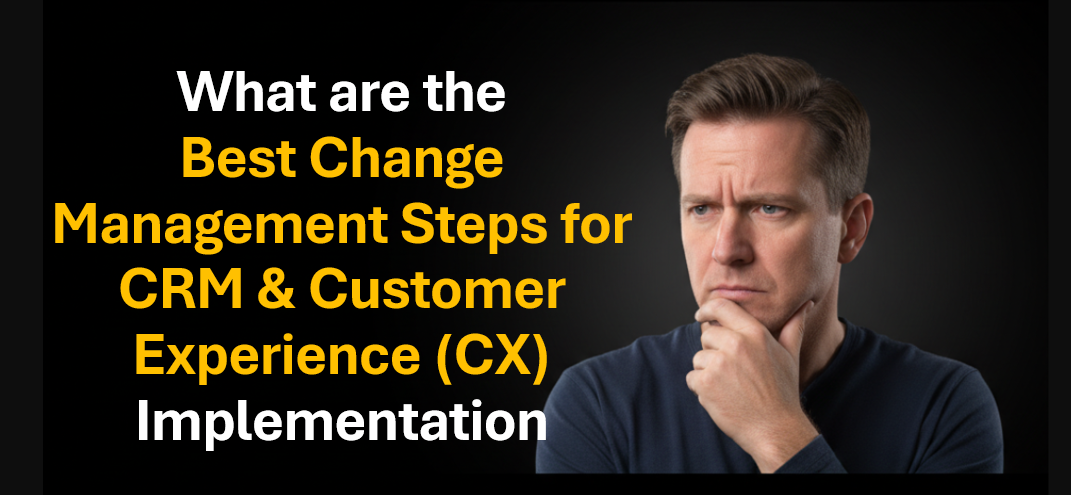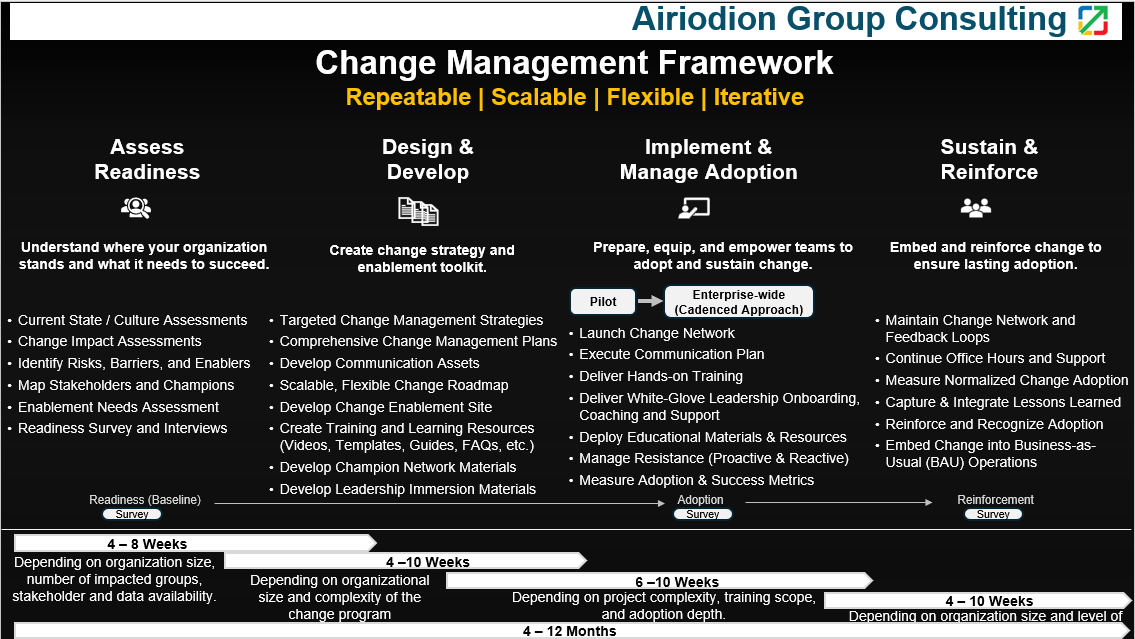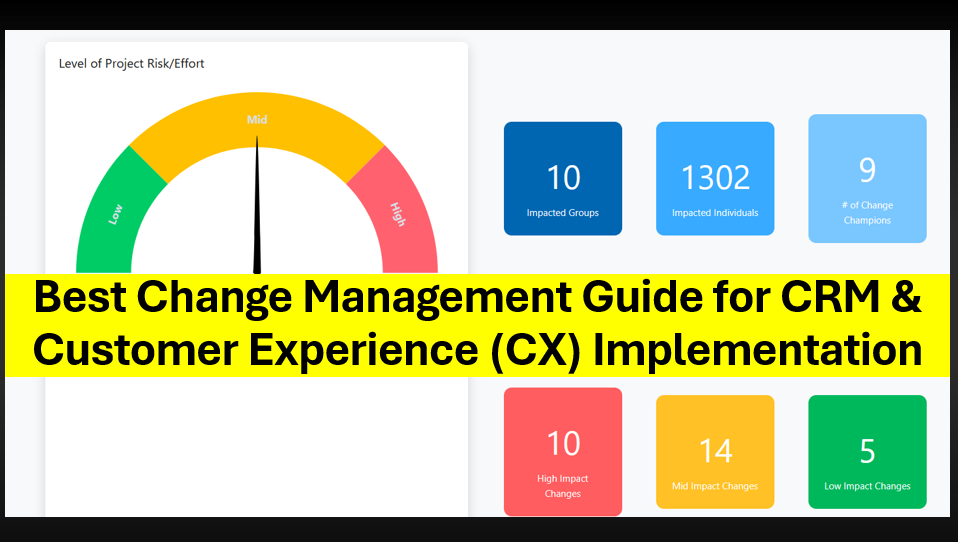Best Change Management Guide for Customer Relationship Management (CRM) & Customer Experience (CX) Implementation
Rolling out a new CRM or Customer Experience (CX) platform is not just a technology upgrade. It represents a shift in how your organization builds relationships, engages customers, and manages information. Without an effective change management approach, even the most advanced CRM and CX systems fail to deliver full adoption or measurable results.
Let’s get started
Watch this video:
or
read the guide below.
This guide shows you exactly how to plan, deliver, and sustain successful organizational change management for CRM and Customer Experience (CX) implementation.
You will learn how to apply a repeatable, scalable, and flexible 4-phase change management framework to your transformation. The guidance in this article is practical, actionable, and designed for project managers, transformation leaders, and change management professionals leading CRM and CX initiatives.

A Repeatable 4-Phase Framework for CRM and CX Change Management
To ensure lasting user adoption and measurable impact, organizations should follow a structured yet flexible approach.
The following 4-phase framework provides the foundation for effective change management during CRM and Customer Experience implementation.
| Phase | Purpose | Primary Outcomes |
|---|---|---|
| 1. Assess Readiness | Evaluate culture, readiness, and potential risks | Establish a baseline for change maturity and alignment |
| 2. Design & Develop | Build strategy, plans, and tools | Develop a comprehensive change management strategy and enablement assets |
| 3. Implement & Manage Adoption | Execute the change enablement activities | Drive user readiness, confidence, and adoption |
| 4. Sustain & Reinforce | Maintain and embed adoption | Reinforce behaviors and ensure long-term success |
This framework helps align people, processes, and technology throughout your CRM and CX transformation. It can be adapted for implementations of Salesforce, Oracle, Microsoft Dynamics, HubSpot, or other platforms.

Phase 1: Assess Organizational Change Readiness
The readiness phase establishes the foundation for all later work. You need to know where your organization stands before you begin. This phase focuses on evaluating the current environment, identifying risks, and building stakeholder alignment.
1. Current State and Culture Assessments
What to do: Assess leadership support, communication culture, decision-making speed, and previous experience with major change.
How to do it: Conduct interviews, employee focus groups, and surveys. Review lessons learned from prior CRM or technology rollouts.
Who to involve: Executives, department heads, HR, IT, and customer-facing teams.
When to do it: During the initial planning or vendor evaluation stage.
Output: A culture and readiness baseline identifying change strengths and weaknesses.
2. Change Impact Assessments
What to do: Document exactly what is changing for each group or role.
How: Conduct workshops and process mapping to analyze system and workflow impacts.
Who: Business analysts, functional leads, and change practitioners.
Output: A detailed change impact matrix identifying scope, audience, and impact level.
3. Identify Risks, Barriers, and Enablers
CRM and CX initiatives often face predictable sources of resistance, such as:
Sales teams feeling micromanaged by new tracking requirements
Customer service agents worrying about increased workloads
Leaders not fully aligned on program goals
Employees experiencing change fatigue
Action: Maintain a risk and enabler register. Include potential obstacles, impact levels, and mitigation strategies.
4. Map Stakeholders and Change Champions
Identify key stakeholders across the organization. The most commonly affected groups include:
Sales and Business Development
Marketing and Digital Experience Teams
Customer Support and Service
Operations
Finance
IT and Data Governance
Human Resources
Legal and Compliance
Executive Leadership
Regional or Field Teams
Action: Map stakeholder influence, level of impact, and readiness. Identify champions from these functions to drive engagement and peer advocacy.
5. Enablement Needs Assessment
Segment audiences by roles and learning preferences. Example personas include:
Sales Representatives: need concise, mobile-friendly tutorials and gamified learning
Service Agents: require process-based learning and live demos
Managers: benefit from leadership toolkits and performance dashboards
Output: A persona-based enablement map defining communication, training, and engagement needs.
6. Readiness Surveys and Interviews
Survey employees to measure awareness, understanding, and willingness to adopt new systems.
Key indicators:
Awareness of CRM initiative goals
Desire to support and participate
Knowledge of how the change affects them
Confidence in leadership and project support
Output: A readiness index or dashboard to monitor progress throughout implementation.
Phase 2: Design & Develop the Change Management Strategy
Once readiness is established, you can design your targeted CRM and CX change management strategy. This phase translates assessments into actionable plans, materials, and tools that will guide the organization through the transition.
1. Develop the Change Management Strategy
Use insights from assessments to define clear change goals and success measures.
Your strategy should answer:
What outcomes must be achieved for CRM adoption success?
How will change activities align with project milestones?
What are the key enablers for behavior change?
Deliverable: A change management playbook summarizing objectives, guiding principles, and overall approach.
2. Create Comprehensive Change Management Plans
Develop a complete set of integrated change management plans to operationalize the strategy. Include:
Change Impact and Readiness Plan
Communication and Engagement Plan
Stakeholder and Sponsorship Plan
Training and Enablement Plan
Resistance Management Plan
Measurement and Adoption Tracking Plan
Change Network Plan
Sustainment and Continuous Improvement Plan
Each plan should define scope, ownership, timing, and success measures.
3. Develop a Scalable and Flexible Change Roadmap
The roadmap sequences communication, training, and reinforcement activities based on project milestones. Example roadmap:
| Phase | Key Activities | Responsible Team |
|---|---|---|
| Planning | Readiness assessments and leadership alignment | Change Team, Executives |
| Design | Strategy development and enablement asset creation | Change Team |
| Deployment | Communication, training, and engagement rollout | Change Network |
| Post Go-Live | Reinforcement, feedback collection, recognition | Change and HR Teams |
4. Develop a Change Enablement Site
Create a central, accessible hub for CRM and CX resources. Include:
Training guides and quick reference cards
Recorded webinars and explainer videos
FAQs, timelines, and key milestones
Feedback channels and recognition highlights
5. Create Training and Learning Resources
Develop multi-format learning to meet diverse needs. Examples include:
Self-paced eLearning modules
Instructor-led sessions
Short “how-to” videos
Role-based simulations and sandbox practice
6. Build the Change Champion Program
Champions play a critical role in influencing peers and reinforcing messages. Provide them with:
A Champion Kickoff Deck introducing program goals
A Champion Toolkit with role descriptions, talking points, and communication tips
A Champion Engagement Plan outlining meeting cadence and responsibilities
A virtual collaboration hub such as Teams or Slack
A guide for identifying and selecting the right champions
7. Develop Leadership Engagement and Immersion Materials
Executives and managers are the visible sponsors of CRM adoption. Support them with:
Leadership Engagement Guide describing purpose and outcomes
Day-in-the-Life role examples to illustrate CRM benefits
Leadership Talking Points Toolkit
Leadership Action Roadmap that outlines how to model and reinforce desired behaviors

Phase 3: Implement and Manage Adoption
During this phase, all plans come to life. The focus shifts to execution, communication, training, and measurement to ensure successful adoption of the CRM and CX platform.
1. Launch the Change Network
Activate your network of champions and leaders. Provide them with updates, talking points, and success stories to share across their teams. Champions should serve as the first line of feedback and advocacy.
2. Execute the Communication Plan
Use a mix of communication channels such as intranet posts, leadership videos, town halls, newsletters, and social feeds.
Focus on clarity and consistency. Communicate the “why,” “what,” and “how” for each audience segment.
3. Deliver Hands-On Training
Offer practical, role-based training focused on real scenarios. Incorporate:
Pre-launch orientation sessions
Post-launch office hours
Job aids and practice labs
4. Deliver White-Glove Leadership Onboarding
Provide leaders with customized onboarding that demonstrates system value in their daily activities. This builds advocacy and visibility among teams.
5. Manage Resistance
Use both proactive and reactive strategies to manage resistance.
Proactive: Identify resistance trends using readiness data and adjust plans accordingly.
Reactive: Address concerns through targeted coaching and open communication forums.
Maintain a resistance tracking log to record issues and resolutions.
6. Measure Adoption and Success Metrics
Establish clear metrics to measure progress and business outcomes. Example metrics:
| Metric | Purpose |
|---|---|
| CRM login and usage rates | Track actual system adoption |
| Training completion percentage | Measure participation levels |
| User satisfaction and sentiment | Gauge confidence and engagement |
| Customer satisfaction (CSAT, NPS) | Monitor impact on customer experience |
| Sales and service performance | Validate return on investment |
Use dashboards to share adoption progress and recognize achievements.
Phase 4: Sustain and Reinforce the Change
After the CRM and CX rollout, reinforcement is critical to prevent regression and maintain adoption. Sustaining the change ensures the organization fully realizes long-term benefits.
1. Maintain the Change Network and Feedback Loops
Continue engaging your change champions and sponsors. Hold regular feedback sessions to identify new pain points and highlight success stories.
2. Continue Office Hours and Support
Offer recurring support sessions to address ongoing questions and onboard new employees.
3. Measure Normalized Adoption
Track performance trends over time to confirm that usage and satisfaction levels remain stable. Use CRM analytics to monitor behavior patterns.
4. Capture and Integrate Lessons Learned
Document lessons learned from the implementation. Use insights to improve future rollouts, updates, or additional modules.
5. Reinforce and Recognize Adoption
Celebrate milestones and reward teams demonstrating high adoption. Recognition programs build morale and sustain engagement.
6. Embed Change into Business-as-Usual (BAU)
Integrate CRM usage expectations into job descriptions, performance reviews, and onboarding programs. This ensures lasting cultural alignment and operational integration.
People Also Ask
What are the best practices for change management in CRM implementation?
How can organizations increase user adoption for CRM and Customer Experience programs?
What are the common barriers to CRM and CX adoption?
How do you measure the success of a CRM and Customer Experience transformation?
What are the essential steps in a CRM change management plan?
Use Case: Global Financial Services CRM and CX Transformation
Program Overview:
A global financial organization implemented a unified CRM and CX platform to improve client relationship management, standardize processes, and enhance customer insights.
Key Challenges:
Fragmented legacy systems
Low frontline user engagement
Lack of consistent leadership sponsorship
Change Management Delivery:
Conducted detailed readiness and impact assessments across 15 departments
Designed and delivered a comprehensive communication and training strategy
Created a change champion network across regions
Developed executive leadership workshops and playbooks
Implemented adoption tracking dashboards
Results:
93 percent user adoption within six months
30 percent improvement in customer response time
25 percent increase in sales team productivity
Leadership sustainment integrated into ongoing operations
How Airiodion Group Consulting Can Help
If you are planning or currently managing a CRM and Customer Experience transformation, Airiodion Group Consulting can help you succeed.
Airiodion Group provides comprehensive change management services for CRM and CX initiatives, including readiness assessments, stakeholder engagement, training development, and adoption sustainment strategies. Their proven methodologies help organizations accelerate adoption, minimize resistance, and achieve measurable results.
Conclusion
A CRM or Customer Experience transformation is not just a system rollout. It is a behavioral and cultural shift that affects how people work, communicate, and serve customers.
By applying the 4-phase change management framework outlined in this guide, you can effectively assess readiness, design strong strategies, implement targeted enablement, and sustain long-term adoption.
This structured approach will help your organization achieve faster CRM adoption, stronger customer engagement, and lasting business impact.
Use this guide as your roadmap to deliver successful, measurable, and people-centered CRM and CX change management.
Note: Content on OCM Solution's ocmsolution.com website is protected by copyright. Should you have any questions or comments regarding this OCM Solutions page, please reach out to Ogbe Airiodion (Change Management Lead) or the OCM Solutions Team today.
Change management for CRM and Customer Experience implementation is a structured process that prepares and supports employees to successfully adopt new CRM systems, workflows, and CX tools. It focuses on engagement, communication, and user adoption to ensure the technology delivers business value and improved customer relationships.
Effective change management ensures that people embrace the new CRM or Customer Experience platform instead of resisting it. It aligns leadership, builds awareness, trains users, and drives adoption. Without structured change management, even advanced CRM implementations often underperform and fail to deliver expected ROI or customer satisfaction improvements.
Typical challenges include user resistance, lack of leadership sponsorship, inconsistent communication, and limited post-launch reinforcement. Many teams struggle with change fatigue or unclear benefits. Addressing these through proactive change management helps sustain CRM adoption and strengthens overall Customer Experience transformation outcomes.
Measuring CRM and CX change success involves tracking user adoption, training completion, engagement levels, and business outcomes. Key metrics include system usage rates, customer satisfaction scores, productivity improvements, and process efficiency. Consistent measurement and reporting ensure continuous improvement and sustained performance gains.
A structured CRM change management process includes readiness assessments, stakeholder engagement, communication planning, training and enablement, resistance management, and post-launch reinforcement. Each phase builds momentum toward successful Customer Experience adoption and aligns people, processes, and technology for long-term business success.
A cross-functional team typically leads CRM and CX change management. Executive sponsors provide direction, change managers design and deliver strategies, and departmental leaders reinforce adoption. Collaboration between project management, HR, IT, and Customer Experience teams ensures alignment and sustained success.
CRM and CX change management begins during planning and continues after go-live. The full lifecycle typically spans six to twelve months, including pre-launch readiness, training, implementation, and sustainment. Continuous reinforcement ensures the organization fully adopts and benefits from its CRM investment.
Resistance is reduced through early communication, leadership visibility, and strong engagement. Change champions, personalized training, and transparent feedback channels help employees understand the benefits of the new CRM tools. Consistent recognition and coaching foster confidence and long-term commitment to the transformation.
Best practices include starting change management early, aligning with leadership, using targeted communication, and providing role-based training. Maintaining feedback loops, tracking adoption data, and recognizing success create sustained engagement and measurable improvement in CRM and CX transformation outcomes.
When employees confidently use CRM systems and CX tools, they deliver faster, more personalized, and consistent service. Effective change management ensures the workforce embraces new processes, leading to improved customer satisfaction, loyalty, and measurable gains in business performance and brand trust.What is change management for CRM and Customer Experience implementation?
Why is change management important for CRM and CX projects?
What are common challenges in CRM and Customer Experience adoption?
How can organizations measure CRM and CX change success?
What are the key steps in a CRM change management process?
Who should lead the change management strategy for CRM and CX implementation?
How long should a CRM and Customer Experience change program last?
How can resistance to CRM and CX change be minimized?
What are best practices for CRM and Customer Experience change enablement?
How does effective change management improve Customer Experience results?
